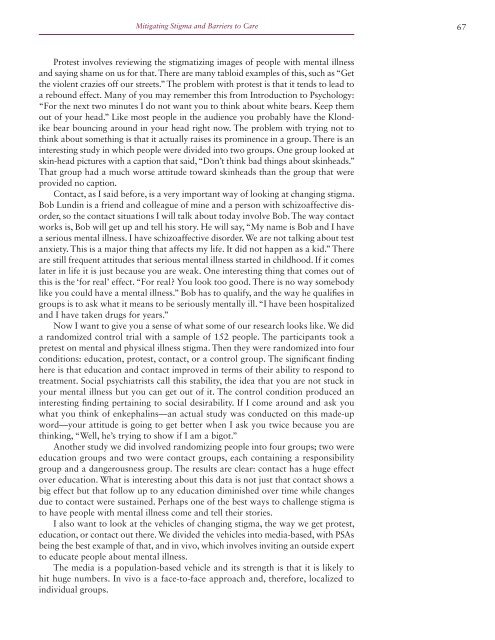stigma and barriers to care - Uniformed Services University of the ...
stigma and barriers to care - Uniformed Services University of the ...
stigma and barriers to care - Uniformed Services University of the ...
You also want an ePaper? Increase the reach of your titles
YUMPU automatically turns print PDFs into web optimized ePapers that Google loves.
Mitigating Stigma <strong>and</strong> Barriers <strong>to</strong> Care 67<br />
Protest involves reviewing <strong>the</strong> <strong>stigma</strong>tizing images <strong>of</strong> people with mental illness<br />
<strong>and</strong> saying shame on us for that. There are many tabloid examples <strong>of</strong> this, such as “Get<br />
<strong>the</strong> violent crazies <strong>of</strong>f our streets.” The problem with protest is that it tends <strong>to</strong> lead <strong>to</strong><br />
a rebound effect. Many <strong>of</strong> you may remember this from Introduction <strong>to</strong> Psychology:<br />
“For <strong>the</strong> next two minutes I do not want you <strong>to</strong> think about white bears. Keep <strong>the</strong>m<br />
out <strong>of</strong> your head.” Like most people in <strong>the</strong> audience you probably have <strong>the</strong> Klondike<br />
bear bouncing around in your head right now. The problem with trying not <strong>to</strong><br />
think about something is that it actually raises its prominence in a group. There is an<br />
interesting study in which people were divided in<strong>to</strong> two groups. One group looked at<br />
skin-head pictures with a caption that said, “Don’t think bad things about skinheads.”<br />
That group had a much worse attitude <strong>to</strong>ward skinheads than <strong>the</strong> group that were<br />
provided no caption.<br />
Contact, as I said before, is a very important way <strong>of</strong> looking at changing <strong>stigma</strong>.<br />
Bob Lundin is a friend <strong>and</strong> colleague <strong>of</strong> mine <strong>and</strong> a person with schizoaffective disorder,<br />
so <strong>the</strong> contact situations I will talk about <strong>to</strong>day involve Bob. The way contact<br />
works is, Bob will get up <strong>and</strong> tell his s<strong>to</strong>ry. He will say, “My name is Bob <strong>and</strong> I have<br />
a serious mental illness. I have schizoaffective disorder. We are not talking about test<br />
anxiety. This is a major thing that affects my life. It did not happen as a kid.” There<br />
are still frequent attitudes that serious mental illness started in childhood. If it comes<br />
later in life it is just because you are weak. One interesting thing that comes out <strong>of</strong><br />
this is <strong>the</strong> ‘for real’ effect. “For real You look <strong>to</strong>o good. There is no way somebody<br />
like you could have a mental illness.” Bob has <strong>to</strong> qualify, <strong>and</strong> <strong>the</strong> way he qualifies in<br />
groups is <strong>to</strong> ask what it means <strong>to</strong> be seriously mentally ill. “I have been hospitalized<br />
<strong>and</strong> I have taken drugs for years.”<br />
Now I want <strong>to</strong> give you a sense <strong>of</strong> what some <strong>of</strong> our research looks like. We did<br />
a r<strong>and</strong>omized control trial with a sample <strong>of</strong> 152 people. The participants <strong>to</strong>ok a<br />
pretest on mental <strong>and</strong> physical illness <strong>stigma</strong>. Then <strong>the</strong>y were r<strong>and</strong>omized in<strong>to</strong> four<br />
conditions: education, protest, contact, or a control group. The significant finding<br />
here is that education <strong>and</strong> contact improved in terms <strong>of</strong> <strong>the</strong>ir ability <strong>to</strong> respond <strong>to</strong><br />
treatment. Social psychiatrists call this stability, <strong>the</strong> idea that you are not stuck in<br />
your mental illness but you can get out <strong>of</strong> it. The control condition produced an<br />
interesting finding pertaining <strong>to</strong> social desirability. If I come around <strong>and</strong> ask you<br />
what you think <strong>of</strong> enkephalins—an actual study was conducted on this made-up<br />
word—your attitude is going <strong>to</strong> get better when I ask you twice because you are<br />
thinking, “Well, he’s trying <strong>to</strong> show if I am a bigot.”<br />
Ano<strong>the</strong>r study we did involved r<strong>and</strong>omizing people in<strong>to</strong> four groups; two were<br />
education groups <strong>and</strong> two were contact groups, each containing a responsibility<br />
group <strong>and</strong> a dangerousness group. The results are clear: contact has a huge effect<br />
over education. What is interesting about this data is not just that contact shows a<br />
big effect but that follow up <strong>to</strong> any education diminished over time while changes<br />
due <strong>to</strong> contact were sustained. Perhaps one <strong>of</strong> <strong>the</strong> best ways <strong>to</strong> challenge <strong>stigma</strong> is<br />
<strong>to</strong> have people with mental illness come <strong>and</strong> tell <strong>the</strong>ir s<strong>to</strong>ries.<br />
I also want <strong>to</strong> look at <strong>the</strong> vehicles <strong>of</strong> changing <strong>stigma</strong>, <strong>the</strong> way we get protest,<br />
education, or contact out <strong>the</strong>re. We divided <strong>the</strong> vehicles in<strong>to</strong> media-based, with PSAs<br />
being <strong>the</strong> best example <strong>of</strong> that, <strong>and</strong> in vivo, which involves inviting an outside expert<br />
<strong>to</strong> educate people about mental illness.<br />
The media is a population-based vehicle <strong>and</strong> its strength is that it is likely <strong>to</strong><br />
hit huge numbers. In vivo is a face-<strong>to</strong>-face approach <strong>and</strong>, <strong>the</strong>refore, localized <strong>to</strong><br />
individual groups.




